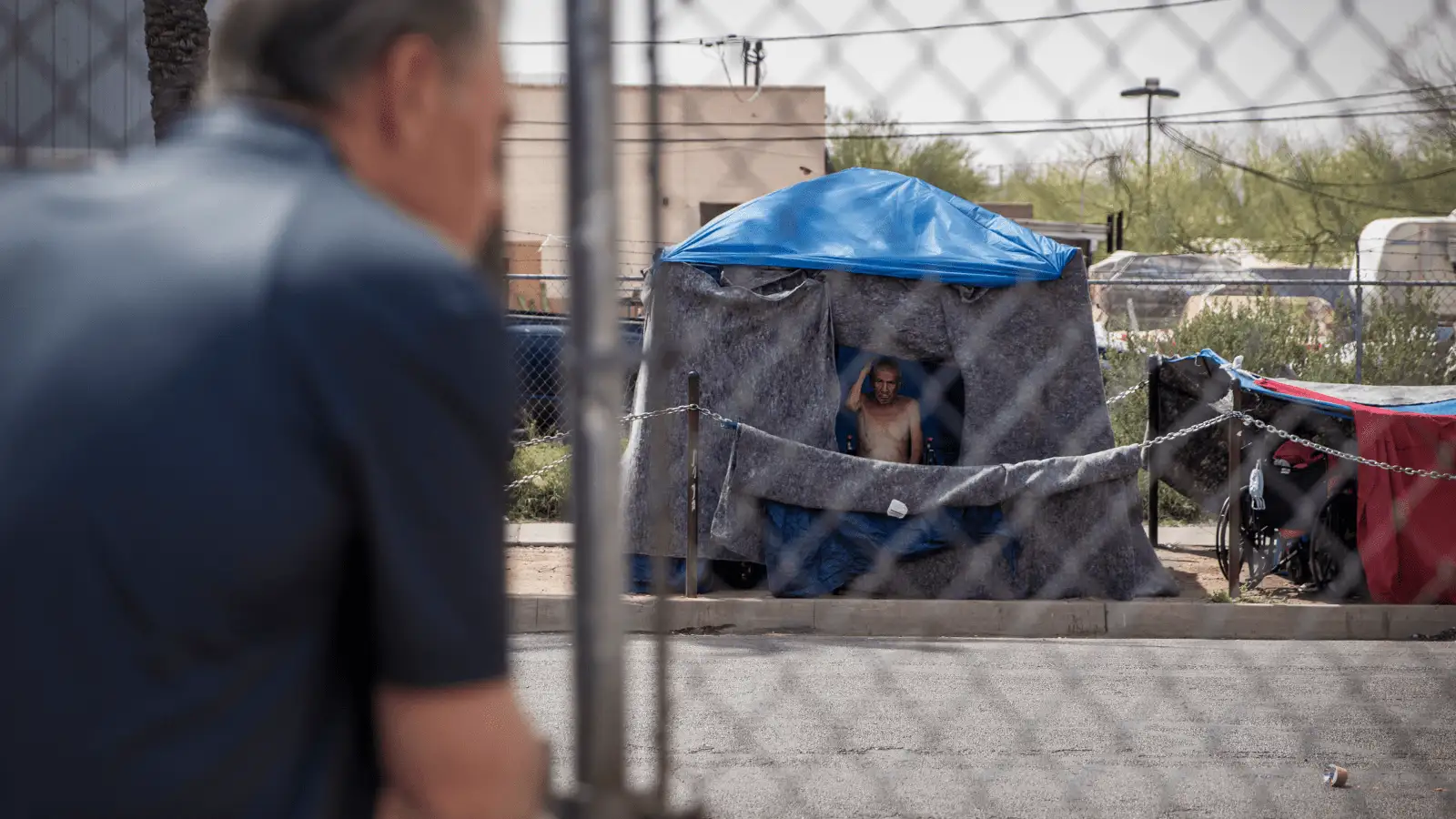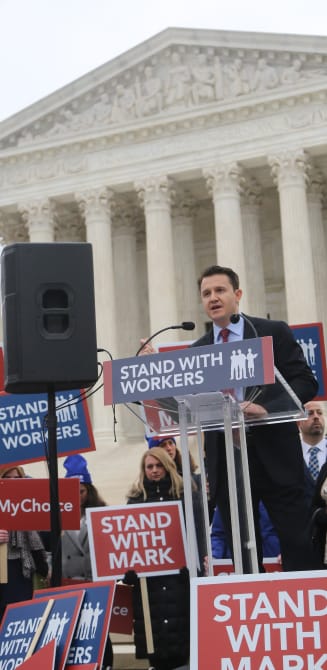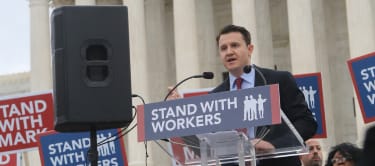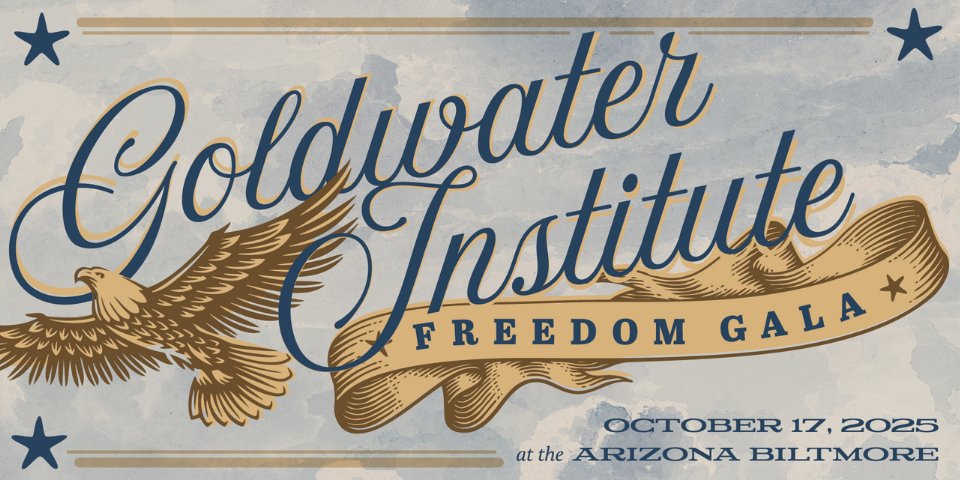In Phoenix, there was “The Zone,” where homeless people slept on the street and crime ran rampant mere blocks from the state capitol. In Tucson, a homeless camp sprung up in the 100-Acre Wood Bike Park, where conditions became unsafe for law-abiding citizens. Though the homeless problem is plain to see, Phoenix and Tucson’s spending on combatting it is anything but transparent. A new analysis by the Goldwater Institute reveals that Phoenix and Tucson have poured hundreds of millions of dollars into various efforts to fight homelessness, yet the homeless population remains stubbornly high and continues to grow.
Taxpayers have been kept in the dark about the cities’ plans to fight the problem, much less whether current efforts are working. And it’s all happening as both cities, the state of Arizona, and the federal government look to spend even more to fight homelessness in the future.
The Goldwater Institute conducted a lengthy investigation to determine how much funding is going toward homelessness services in each of these cities, where it’s coming from, which vendors are receiving contracts for homelessness projects, and how that money is being used. The answers we found are sometimes surprising and do not always present a clear picture.
Homelessness Out of Control
Over the last several years, homelessness has risen dramatically in Maricopa County (which includes Phoenix) and Pima County (which includes Tucson). Both counties determine their homeless populations by conducting an annual “point in time” (PIT) count over the course of one day, and the results are then made public. According to the PIT count, the total number of homeless individuals in Maricopa County rose from 5,605 in 2017 to 9,642 in 2023, a 72% increase. As seen in the chart below (which includes both sheltered and unsheltered homeless), the total homeless population rose every year from 2018 to 2023, with a marginal drop in 2024—despite a massive influx of spending.
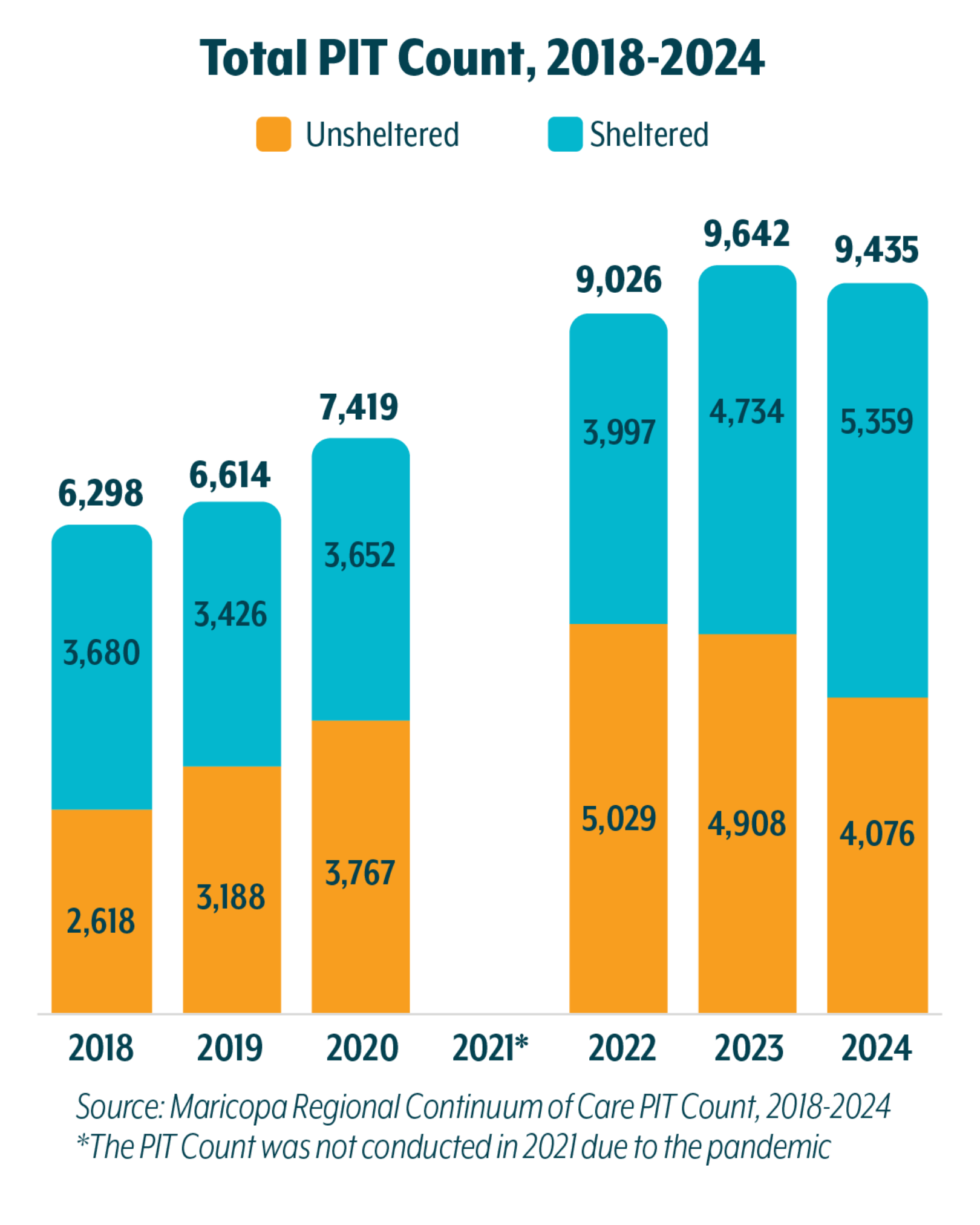
Phoenix has fared even worse in important measures. The PIT count found 3,333 unsheltered individuals in Phoenix in 2023, up from 1,735 in 2018, representing an astonishing 92% increase over a five-year period. The number of unsheltered individuals in Phoenix rose every year from 2018 to December 2023.[1] In May 2024, the city of Phoenix announced a new PIT count for 2024, revealing that “the number of unsheltered individuals in Phoenix decreased by 19 percent, from 3,333 people in 2023 to 2,701 in 2024.” Meanwhile, the total population of people experiencing homelessness in Phoenix “decreased by just over 1% from 6,902 in 2023 to 6,816 in 2024,” a miniscule decline given the vast investment of taxpayer dollars.[2] It’s also worth noting that the decrease came only after a court ordered the city to clean up the homeless “Zone” in downtown Phoenix in 2023, where 1,000 people resided.[3]
In Pima County (which includes Tucson), the PIT count found 2,209 homeless individuals as of January 2023, a 60% increase from 2018.[4] The PIT count did not appear to break down the numbers for Tucson alone.
The PIT figures likely underestimate the true homeless population because the methodology is admittedly flawed. As one media outlet writing about Phoenix’s homeless population acknowledged, “The point-in-time data almost certainly undercounts the Valley’s homeless population. Many unsheltered people hide, move locations throughout the day or are otherwise out of sight and thus aren’t counted. Bad weather, too few volunteers and human error also limit the count’s accuracy.”[5] Therefore, the homelessness figures in these areas could be higher and even more difficult to address.
Phoenix
The natural starting point for any inquiry on homelessness within the city is the Phoenix Office of Homeless Solutions (OHS), which “provides support for people experiencing homelessness and is committed to ending homelessness through a comprehensive, regional approach to shelter and heat relief, outreach, supportive and behavioral health services, homelessness prevention, and supportive housing.” OHS’s website says that $140 million has been committed to homeless solutions since July 2021, and projects will run into at least 2024. The funding sources include $127.3 million from federal grants (including the American Rescue Plan Act of 2021), $7 million from the Arizona Department of Housing (ADOH), and $5.7 million in annual funding.[6] OHS has also announced that Phoenix will receive an additional $13.3 million from ADOH for shelter and other homelessness services.[7]
With so much funding available, transparency in how those dollars are spent is important. Yet OHS provides an incomplete and inadequate accounting of the $140 million it says has been allocated for homelessness. OHS’s website lacks essential information, with a breakdown on only $47.6 million of the spending, or roughly 34% of the total.[8] The $47.6 million figure is itself sometimes opaque and incomplete. OHS, for example, lists a joint investment between Phoenix and Maricopa County, but does not break down the sources of the funding, meaning Phoenix could be paying close to all or none of the costs. OHS’s website also lists $34.5 million in spending by Maricopa County and ADOH on projects in Phoenix, but it is not clear whether those funds are included as part of the $140 million allocated. Further, the programs do not have start and end dates, meaning it is unclear whether they are in progress or completed.
Goldwater’s independent investigative research, which relied on such public records as ordinances, budget reports, and contracts, reveals that Phoenix has allocated over $180 million to homelessness services since 2021 through a combination of federal, state, and local funding—far more than reported by OHS. Even this amount underestimates the true dollar figure because certain federal and state funds, as well as private funding for homeless solutions, are budget line items not counted as part of the city’s spending. When this type of additional funding is taken into account, over $250 million has been allocated to address homelessness in Phoenix since 2021, an astounding sum that has not moved the needle on the problem.
Of the $180-plus million in contracts Phoenix entered into with vendors for services related to homelessness, the following vendors have the largest cumulative contracts for homelessness, all of which are over $1 million. The table below includes Phoenix’s costs for these services, as well as the “total service cost” (i.e., any combination of Phoenix/state/federal/private donations, etc.).[9]
The City of Phoenix’s Largest Cumulative Contracts to Combat Homelessness (2021-2024)
| Organization | Phoenix Cost | Total Service Cost | Purpose |
| Community Bridges | $29,869,568 | $37,334,854 | Property, Housing & Rapid Rehousing, Outreach for Shelter Support Services |
| BRYCON | $16,000,000 | $16,000,000 | Shelter Space and General Contracting Services |
| St. Vincent de Paul | $13,024,305 | $27,273,131 | Emergency Shelter, Transitional Housing, Hotel Operation |
| Central Arizona Shelter Services (CASS) | $9,402,625 | $14,833,468 | Housing, Shelter and Homeless Support Services |
| Mercy Care | $9,000,000 | $9,000,000 | Behavioral Health/Mental Health Services |
| Human Services Campus Inc. | $7,010,401 | $15,512,521 | Relief Sprung Structure for Shelter |
| Salvation Army | $6,218,993 (city approved $6,000,000 in funding that has yet to be contracted) | $7,124,842 | Shelter, Street Outreach |
| A New Leaf | $4,598,423 | $9,206,130 | Rapid Rehousing, Homeless Youth Reunification (includes possible hotel operation) |
| UMOM Day Centers | $4,495,264 | $29,718,600 | Shelter, Street Outreach |
| Steel & Spark | $2,624,000 | $2,624,000 | X-Wing Shelter Units |
| Homeward Bound | $2,348,795 | $3,183,601 | Homelessness Prevention, Including GED and Job Training |
| St. Joseph the Worker | $2,000,000 | $2,997,533 | Workforce Villages – Paying Housing Costs |
| Child Crisis Arizona | $1,226,459 | $1,827,509 | Shelter for Homeless Minors |
| Southwest Behavioral Health Services | $1,035,702 | $1,599,967 | Criminal Justice for Homeless/Outreach |
Phoenix allotted an additional $63,000,000 for city-owned shelters, emergency rental assistance, property acquisition, hotel conversion, and affordable housing. Much of this money has yet to be distributed for specific projects.[10]
How Phoenix determined what services should be prioritized is described in the 2021 report “Strategies to Address Homelessness.” The report states that in 2020, Phoenix city staff presented the mayor and Phoenix City Council with a plan to address homelessness. The City Council adopted a modified version of the plan, and a Task Force composed of “neighborhood leaders, service providers and homeless advocates began meeting to prioritize and provide recommendations on the city’s efforts to deploy the plan.” Goldwater notes that four of the 19 members of the Task Force were associated with organizations that had contracts with Phoenix (Southwest Behavioral Health, Chicanos Por La Causa, Central Arizona Shelter Services, and Mercy Care). It is unclear how, if at all, the city addressed the potential conflicts of interest that could arise from vendors who provide homelessness services to Phoenix making recommendations on homelessness.[11]
Tucson
Determining how much Tucson[12] actually spends on homelessness requires sorting through disparate public information, and the results do not clearly add up. A 2023 report by The Tucson Pima Collaboration to End Homelessness (TPCH), a collection of Tucson-area organizations focusing on homelessness, estimates that through federal, state, local, and philanthropic sources, between $50 million and $70 million is spent annually on homelessness in Pima County. The report notes that these programs include direct cash assistance for supportive housing, street outreach, childcare, nutrition, addiction recovery, and other services. But the report does not break down the funding to name the sources or provide details as to how it arrived at its calculation.[13]
Pima County records provide another resource on homelessness funding and show that the county budgeted the following for personnel and operations:
2021-22 $4,820,507
2022-23 $7,651,954
2023-24 $5,334,470[14]
These amounts total $17.8 million over three years, and it is unclear whether this annual spending on homelessness is included in TPCH’s report. Although spending on homelessness can be calculated in a variety of ways, the lack of clear and transparent accounting makes it difficult to understand the relationship, if any, between TPCH’s reports and the county budgets. More important, without understanding the various monetary inputs and outputs, one cannot understand or analyze whether money is being spent appropriately in Pima County.
A third, separate, source on homelessness spending in Pima County only adds to the confusion. Goldwater reviewed contracts and administrative expenses available on Pima County’s website in a further attempt to calculate spending on homelessness since 2021, including prevention. According to this methodology, Pima County’s contracts with vendors totaled almost $27 million, including some administrative expenses between 2021 and 2024, with the largest aggregate contracts (over $500,000) noted below:
Pima County’s Largest Cumulative Contracts to Combat Homelessness
(2021-2024)
| Organization | Amount | Purpose |
| World Dining LLC | $13,400,000 | Food |
| City of Tucson | $6,046,272 | Emergency Food & Shelter |
| Our Family Services Inc. | $1,749,880 | Housing, Rapid Rehousing, Rental Assistance, and Case Management |
| Compass Affordable Housing Inc. | $850,000 | Housing |
| Interfaith Community Services | $823,384 | Utility, Rental, and Mortgage Assistance |
| Community Bridges Inc. | $752,477 | Housing, Employment, and Substance Abuse services |
| Catholic Community Services of So Arizona Inc. PIO Decimo Center | $562,386 | Transitional Housing for Families, Childcare |
Both the aggregate spending and the $9 million in annual spending for contracts related to homelessness are far higher than Pima County’s budget yet far lower than TPCH’s calculations. Again, this may be for a variety of reasons, but the lack of explanation on how spending is calculated prevents an apples-to-apples comparison of the numbers. Further, as Pima County does not appear to have a centralized, easy-to-locate repository of all contracts related to homelessness for the relevant period, Goldwater had to use a variety of approaches and search terms to assemble the information, and therefore we could not guarantee that all relevant contracts were included.
Goldwater notes that TPCH’s estimate of annual homelessness spending is much higher than what we’ve been able to document independently from other available sources. Regardless, the organization says its high estimate of $50 million to $70 million of annual spending isn’t even enough to defeat homelessness in Pima County, according to TPCH’s 2023 report:
In total, an additional 1,367 additional emergency shelter beds and 4,901 supportive housing units, including transitional, rapid rehousing, and permanent supportive housing units, are projected to be needed within the next five years to achieve and sustain functional zero, the point at which existing system capacity is sufficient to ensure that homelessness is rare, brief, and one time. The total annual cost of rental assistance and essential case management services necessary to achieve functional zero is estimated to be between $135.8M and $158.5M. (emphasis added).
TPCH’s funding recommendation would double or triple the amount it estimates is already being spent on homelessness in Pima County, and the additional spending would continue indefinitely. TPCH’s calculation also appears to focus mostly on housing, rather than the complex social issues that contribute to the homeless crisis in Pima County.[15] The report does not address how the money would be raised, a particularly difficult question as the vast majority of the contracts Goldwater reviewed for homelessness services were funded through federal COVID-relief funds, which cannot be relied upon as a resource in the future.
The nationwide migrant crisis adds another layer of complexity to approaching homelessness in Tucson. It is important to understand whether migrants who have entered the country in record numbers are categorized as homeless, because that can have large implications on Tucson’s resources, taxpayers, and residents. The World Dining contract (listed in the table above), for example, includes asylum seekers along with the homeless.[16] Funding for unaccompanied youth may also potentially include minors who have crossed the border without their parents. As the swell of migrants coming into the United States continues illegally, it could mean that Tucson—and Pima County—will need to devote outsized, potentially unsustainable resources to an ever-expanding category of homeless.
Despite the enormous funds that Phoenix and Tucson have devoted to addressing homelessness, a permanent, sustainable solution appears elusive. In Tucson and Pima County, one administrator warned that the region is facing “homelessness on steroids” as funds to fight homelessness run out.[17] Meanwhile, Phoenix has entered into multimillion-dollar contracts with the same small group of vendors, without a dent in its unsheltered homeless population. One of those vendors, Central Arizona Shelter Services, recently reported it is facing a $1.5 million shortfall, despite being allocated nearly $15 million in funding, including $9.4 million from Phoenix alone, as this report reveals.[18]
Faced with the unrelenting homelessness problem—and federal deadlines to spend one-time funding—the Phoenix City Council approved using another $15 million in federal COVID rescue funds for shelters throughout the city in February 2024.[19] But the federal funds are running out, and the city will be forced to find new ways to pay for the ongoing homeless programs. Phoenix City Manager Jeff Barton recently raised an alarm for the council, urging, “The reality is, at some point, something’s gotta give … We don’t have all the money in the world. So we will have to make tough decisions.”[20]
With more expenses ahead, Phoenix city officials are playing a blame game and are looking for others to pick up the bill in ongoing costs. As the Arizona Republic reports, “City Manager Jeff Barton denied any financial irresponsibility on the city’s part, saying the future budgets could have handled all the new homeless programs had the state not ‘ripped the rug from us’ by ending the rent tax and undervaluing the cost of the flat tax.” Phoenix Mayor Kate Gallego pointed the blame at the state legislature, who she said “cut revenue for nearly every city in Arizona.” Meanwhile, city councilmembers have called on other cities and the state to help pay for homelessness services.[21]
But with the spending on homelessness continuing to mount—as the homeless population continues to grow—the question should not be where to find more funding. Rather, it should be whether funding alone, no matter how extensive, is the answer to homelessness in these cities.
Download a PDF of the report here.
End Notes
[1] Maricopa Association of Governments, “Point-in-Time Homelessness Count,” January 23, 2024, https://azmag.gov/Programs/Homelessness/Data/Point-In-Time-Homelessness-Count; Juliett Rihl, “Homelessness in Arizona Is Still on the Rise, Count Shows,” AZCentral, November 25, 2023, https://www.azcentral.com/story/news/local/phoenix/2023/05/03/homeless-population-rose-in-metro-phoenix-over-the-past-year/70177209007/; see also Maricopa Regional Continuum of Care, “Homelessness Trends Report: 2021 Summary,” https://azmag.gov/Portals/0/Homelessness/Reports/Homelessness-Trends-Report-2021.pdf?ver=VUI-2OBWGR3Y5kMOiJEKKA%3d%3d. Maricopa County also reports on households that engage with homeless service providers. In September 2023, there were 7,846 actively homeless individuals according to this measure; see Maricopa Regional Continuum of Care, “Homelessness Trends Report: July-September 2023,” https://azmag.gov/Portals/0/Homelessness/Reports/2023-Q3-Homelessness-Trends-Report.pdf.
[2] Ford Hatchett, “Following up: Results of Maricopa County ‘Point in Time’ homeless count published,” ABC 15 Arizona, May 22, 2024, https://www.abc15.com/news/local-news/following-up-results-of-maricopa-county-point-in-time-homeless-count-published#:~:text=In%20total%2C%20there%20were%209%2C435,%2C%E2%80%9D%20Mayor%20Kate%20Gallego%20said.
[3] Tannya Barba, “Judge orders City of Phoenix to clean up homeless encampment known as ‘The Zone’,” ABC 15 Arizona, March 27, 2023, https://www.abc15.com/news/local-news/judge-orders-city-of-phoenix-to-clean-up-homeless-encampment-known-as-the-zone.
[4] The Tucson Pima Collaboration to End Homelessness, “2023 Point in Time Count Report of Persons Experiencing Homelessness and Shelter/Supportive Housing Utilization in Pima County, AZ,” May 15, 2023, page 4, https://tpch.net/wp-content/uploads/TPCH-2023-Point-in-Time-Count-Housing-Utilization-Report-5.15.23.pdf. Tucson in Pima County, Arizona, accounts for the majority of the county’s population. Reports to the public provide statistics and spending on homelessness in Pima County rather than Tucson specifically.
[5] Sarah Lapidus, “Homeless People in Tucson Are Struggling to Get Services,” Arizona Republic, December 21, 2023, https://www.azcentral.com/story/news/local/arizona/2023/11/02/ua-report-finds-homeless-people-in-tucson-struggle-to-get-services/71400919007/.
[6] City of Phoenix, Homelessness Solutions Funding, March 2023, https://www.phoenix.gov/solutions/Documents/OHS%20Funding%20Sheet%20Updated%20March%202023.pdf.
[7] City of Phoenix, “Phoenix Receives $13.3 Million Grant Towards Addressing Homelessness,” Newsroom, June 7, 2023, https://www.phoenix.gov/newsroom/homeless-solutions/2774. Goldwater subsequently learned that the $13.3 million will be allocated as followings: The city will pay St. Vincent de Paul $3,844,616 to operate the City Center Motel and $3,480,038 to either Mercy House or A New Leaf to operate a Howard Johnson. The remainder, $5,975,345, will be used for state property.
[8] City of Phoenix, Office of Homeless Solutions, https://www.phoenix.gov/solutions.
[9] All total service costs were obtained directly from the total service spending amounts listed in contracts between Phoenix and the applicable vendor.
[10] City-Owned Sprung Structure and Non-Congregate Shelter $12,000,000.00; Emergency Rental Assistance $414,792; Hotel Conversion $14,000,000; Housing Phoenix Plan/Landlord Incentive Plan $5,500,000; Phoenix ESG $10,000; Phoenix seeking Real Property Rights $15,000,000; Rental Rehabilitation Program $1,000,000; State of Arizona $1,700,000. An additional $15,090,360 has been allocated for the following: Emergency Crisis Shelter for Families Prioritized by Phoenix Public Safety and Human Services Officials; Scope of Work 2 – Rapid Rehousing and Housing Stabilization Support; Scope of Work 3 – Navigation and Wrap Around Services for Justice Involved Individuals Experiencing Homelessness; Scope of Work 4 – Outreach and Engagement for Persons Experiencing Homelessness; Scope of Work 5 – Phoenix Community Action Response Engagement Services Outreach; Scope of Work 6 – Homeless Youth Reunification. Also $2.4 million in contracts have Contract Term. The term for the contracts for Scopes of Work 1-5 will begin on or about July 1, 2023, and end June 30, 2024, with four, one-year options to extend. The contract for Scope of Work 6 will begin on or about July 1, 2023, and run through December 31, 2024.
[11] City of Phoenix, “Strategies to Address Homelessness,” Task Force Recommendations to the City Manager, 2021, https://www.phoenix.gov/humanservicessite/Documents/Task%20Force%20Recommendations%20to%20the%20City%20Manager-Final.pdf.
[12] The Tucson Metropolitan Statistical Area was comprised of 1,072,298 residents in 2022, a 1.3% annual population increase (see Making Action Possible for Southern Arizona, “Examine Population Growth Rate in Tucson, Arizona MSA,” Population Profile, 2023,
https://mapazdashboard.arizona.edu/workforce-demographics/population-profile). However, the U.S. Census Bureau uses a different calculation for Tucson, stating it has 542,656 residents (see U.S. Census Bureau, Quick Facts, Tucson City, Arizona, July 1, 2023, https://www.census.gov/quickfacts/fact/table/tucsoncityarizona/PST045222).
[13] Tucson Pima Collaboration to End Homelessness, “The Cost of Ending Homelessness in Pima County,” 2023, https://tpch.net/wp-content/uploads/TPCH-2023-System-Modeling-and-Gaps-Analysis-Report.pdf.
[14] Pima County, Adopted Budget, Fiscal Year 2023/2024, https://content.civicplus.com/api/assets/b011c482-81dd-409a-a88c-70cbe5476ea4.
[15] Tucson Pima Collaboration to End Homelessness.
[16] The World Dining contract states the following: “Program Goals/Predicted Outcomes: To provide emergency food to individuals experiencing, and at risk of experiencing homelessness, including asylum seekers sheltered at CAWC and at overflow hotels. Public Benefit: Providing food, shelter and supportive services keeps legally present homeless individuals off the streets and mitigates the spread of COVID-19 in Pima County.” See contract # MA-PO-22-084, Pima County, Board of Supervisors Agenda Report, https://onbase.pima.gov/publicaccess/PO_NextGen_Single/api/Document/AfThxtGaWsJI%C3%81AhOWY0sSVQbjSMf%C3%81KmmVFQ46IWQMnEj56xNM7JmbtacfNd87AV2jClvUvu7Z52IC7hWPEXVCY8%3D/.
[17] Emily Bregel, “Tucson to See ‘Homelessness on Steroids’ as Migrant-Aid Funds Dry Up,” Tucson Citizen, February 18, 2024,
https://tucson.com/news/local/border/pima-county-arizona-migrant-aid-asylum-seekers-catholic-shelters-bishop-harassment/article_5878fda8-c6a4-11ee-ace6-ff143efa28b2.html.
[18] Christina Estes, “Arizona’s Biggest Homeless Services Program Faces $1.5M Shortfall,” KJAZZ, April 4, 2024,
https://kjzz.org/content/1871432/arizonas-biggest-homeless-services-program-faces-15m-shortfall.
[19] Christina Estes, “Phoenix councilman says spending on homelessness is ‘getting out of hand,’” KJAZZ, April 4, 2024,
https://kjzz.org/content/1871978/phoenix-councilman-says-spending-homelessness-getting-out-hand.
[20] Taylor Seeley, “Phoenix Spends $15M on Homelessness but May Have to Cut Elsewhere: ‘Something’s Gotta Give,’” Arizona Republic, February 22, 2024,
[21] Seeley.



